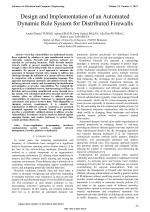| 3/2023 - 4 |
Design and Implementation of an Automated Dynamic Rule System for Distributed FirewallsTUDOSI, A.-D. |
| Extra paper information in |
| Click to see author's profile in |
| Download PDF |
Author keywords
application programming interfaces, communication system security, computer network management, firewalls, platform virtualization
References keywords
link(7), firewall(7), network(6), firewalls(6), distributed(6), intelligent(4), architecture(4), application(4)
Blue keywords are present in both the references section and the paper title.
About this article
Date of Publication: 2023-08-31
Volume 23, Issue 3, Year 2023, On page(s): 29 - 38
ISSN: 1582-7445, e-ISSN: 1844-7600
Digital Object Identifier: 10.4316/AECE.2023.03004
Web of Science Accession Number: 001062641900004
SCOPUS ID: 85172371749
Abstract
Zero-day vulnerabilities are undisclosed security flaws exploited by attackers to gain unauthorized access to vulnerable systems. Firewalls and antivirus software are essential for preventing intrusions. While firewalls monitor network traffic to prevent unauthorized access, they may struggle to filter all incoming traffic due to attacker-generated anomalies. We present a novel approach to automate the generation of dynamic firewall rules, aiming to address this challenge through the utilization of a custom software solution in conjunction with a suitable programming language. This approach autonomously maintains and updates firewall rules, bolstering network security and streamlining the identification and mitigation of zero-day vulnerabilities. We evaluated the approach on a simulated network, demonstrating its efficacy in detecting and preventing unauthorized access through zero-day attacks. Our automated method for dynamic firewall rule creation offers an efficient means to address zero-day vulnerabilities. It empowers businesses to safeguard against cyberattacks and protect sensitive data. With adaptability to changing network requirements, it is valuable for organizations of different scales. In conclusion, our proposed automated approach for dynamic firewall rule generation provides a scientifically validated solution to address zero-day vulnerabilities. It enhances security measures, defends against emerging threats, and enables businesses to protect their systems and data effectively. |
| References | | | Cited By |
Web of Science® Times Cited: 0
View record in Web of Science® [View]
View Related Records® [View]
Updated today
SCOPUS® Times Cited: 2
View record in SCOPUS® [Free preview]
View citations in SCOPUS® [Free preview]
There are no citing papers in the CrossRef Cited-by Linking system.
Disclaimer: All information displayed above was retrieved by using remote connections to respective databases. For the best user experience, we update all data by using background processes, and use caches in order to reduce the load on the servers we retrieve the information from. As we have no control on the availability of the database servers and sometimes the Internet connectivity may be affected, we do not guarantee the information is correct or complete. For the most accurate data, please always consult the database sites directly. Some external links require authentication or an institutional subscription.
Web of Science® is a registered trademark of Clarivate Analytics, Scopus® is a registered trademark of Elsevier B.V., other product names, company names, brand names, trademarks and logos are the property of their respective owners.
Faculty of Electrical Engineering and Computer Science
Stefan cel Mare University of Suceava, Romania
All rights reserved: Advances in Electrical and Computer Engineering is a registered trademark of the Stefan cel Mare University of Suceava. No part of this publication may be reproduced, stored in a retrieval system, photocopied, recorded or archived, without the written permission from the Editor. When authors submit their papers for publication, they agree that the copyright for their article be transferred to the Faculty of Electrical Engineering and Computer Science, Stefan cel Mare University of Suceava, Romania, if and only if the articles are accepted for publication. The copyright covers the exclusive rights to reproduce and distribute the article, including reprints and translations.
Permission for other use: The copyright owner's consent does not extend to copying for general distribution, for promotion, for creating new works, or for resale. Specific written permission must be obtained from the Editor for such copying. Direct linking to files hosted on this website is strictly prohibited.
Disclaimer: Whilst every effort is made by the publishers and editorial board to see that no inaccurate or misleading data, opinions or statements appear in this journal, they wish to make it clear that all information and opinions formulated in the articles, as well as linguistic accuracy, are the sole responsibility of the author.





